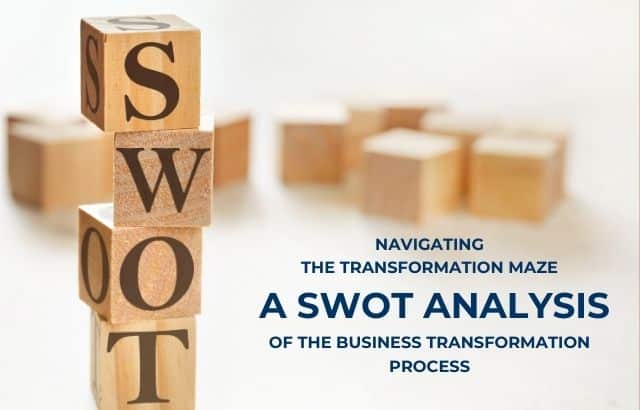For entrepreneurs, navigating the ever-changing business landscape requires constant adaptation and evolution.
Enter business transformation, a potent weapon in the arsenal of those seeking to stay ahead of the curve.
But like any powerful tool, it comes with its own strengths, weaknesses, opportunities, and threats.
Let’s dive into a SWOT analysis of the business transformation process, specifically geared towards the intrepid entrepreneur.
Table of Contents
Strengths:
- Renewed Growth: Transformation can reignite stagnant businesses, unlocking new markets, streamlining operations, and boosting efficiency. It’s a potent jolt to lethargy, propelling companies towards higher ground.
- Enhanced Agility: In today’s dynamic environment, adaptability is key. Transformation fosters a culture of innovation and openness to change, equipping businesses to respond swiftly to emerging trends and disruptions.
- Competitive Advantage: Done right, transformation can elevate a company from the pack, creating a unique value proposition and solidifying its position in the market. This translates to stronger customer loyalty,increased brand recognition, and a differentiated competitive edge.
Weaknesses:
- Disruption and Discomfort: Change, while necessary, can be inherently disruptive. Transformation can lead to temporary inefficiencies, employee anxieties, and potential resistance to new systems and processes. Smooth communication and robust change management are crucial to mitigate these challenges.
- Resource Intensive: Transformation requires significant investments in time, manpower, and financial resources. Careful planning, budget allocation, and resource optimization are key to ensuring a successful and sustainable transformation journey.
- Uncertainty and Risk: Embarking on any new path comes with inherent risks. Transformation, with its focus on the unknown, can exacerbate these anxieties. Implementing a data-driven approach, setting realistic goals, and continuously monitoring progress can help mitigate these risks and navigate the transformation journey with confidence.
Opportunities:
- Leveraging Technology: Emerging technologies like AI, big data, and automation present game-changing opportunities for businesses undergoing transformation. Embracing these tools can streamline processes,enhance decision-making, and unlock new avenues for growth.
- Cultivating Innovation: Transformation creates the perfect breeding ground for innovative ideas. By empowering employees and fostering a culture of experimentation, entrepreneurs can leverage the transformation process to uncover game-changing ideas and unlock their full potential.
- Building Resilience: Successful transformation builds a company’s resilience to future disruptions. By developing adaptable systems, cultivating a learning culture, and embracing change, entrepreneurs can equip their businesses to thrive in any uncertain future.
Threats:
- Leadership Failure: Ineffective leadership can cripple even the most well-crafted transformation plan. Strong leadership with a clear vision, effective communication skills, and unwavering commitment is critical to navigating the complexities of transformation and inspiring others to follow.
- Poor Planning and Execution: Rushing into transformation without thorough planning and execution can be disastrous. A comprehensive roadmap, effective change management strategies, and robust metrics to track progress are essential for keeping the transformation process on track and avoiding costly pitfalls.
- Talent Retention: Transformation can lead to changes in roles and responsibilities, potentially unsettling employees and leading to talent loss. Effective communication, skill development programs, and transparent change management strategies are crucial to retaining key talent and minimizing disruptions.
Conclusion:
Business transformation remains a powerful tool for entrepreneurial success. While not without its challenges, a thorough understanding of its strengths, weaknesses, opportunities, and threats can empower entrepreneurs to leverage its potential and navigate the transformation maze with confidence and clarity. By staying informed, embracing change, and prioritizing effective leadership and planning, entrepreneurs can transform their businesses not just into thriving enterprises, but into resilient and future-proofed champions of the ever-evolving marketplace.






















